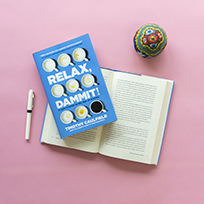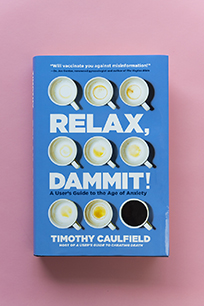Page Content
How many cups of coffee is too many? Should the toilet seat be left up or down? Is multitasking all it’s cracked up to be?
 These and other burning questions are masterfully answered by Timothy Caulfield in Relax, Dammit! A User’s Guide to the Age of Anxiety. Caulfield is a Canada research chair in health law and policy, a professor in the faculty of law and the school of public health, and research director of the Health Law Institute at the University of Alberta.
These and other burning questions are masterfully answered by Timothy Caulfield in Relax, Dammit! A User’s Guide to the Age of Anxiety. Caulfield is a Canada research chair in health law and policy, a professor in the faculty of law and the school of public health, and research director of the Health Law Institute at the University of Alberta.
Like Caulfield’s documentary series A User’s Guide to Cheating Death, Relax, Dammit! explores the science behind the fads and fashions that make up our collective (un)scientific wisdom. Caulfield takes the reader through a typical day, from waking up, checking the phone and stepping on the bathroom scale to flossing, cuddling and sleeping. In between, he encourages the reader to choose soap over hand sanitizer, paper towels over hand dryers and pasteurized milk over raw milk.
Caulfield is enthusiastic about allowing children to walk to school on their own, easier said than done given that not all children attend their neighbourhood school. The fear of stranger abduction is vastly overrated, he says.
“A 2015 position statement authored by 19 academic experts on outdoor play concluded that the chance of a child being abducted by a stranger is about one in 14 million. This makes the possibility so fantastically remote that, in terms of daily risks, it can be categorized as ‘simply not going to happen.’”
Caulfield doesn’t mince words when it comes to email: “an evil, time-sucking, joy-killing grey blob that follows me everywhere I go.” Large email volume, he says, is connected to higher levels of work stress and lower levels of work satisfaction. “My suggestion is to, yep, relax,” he concludes. “Turn off your alerts, do your best to create a few blocks of email-free time, focus on the key emails, file away or delete as much as possible, and develop a strategy to simply say no.”
When it comes to exercise, Caulfield says there’s nothing magical about 10,000 steps.
“This widely accepted and oft-repeated goal is completely arbitrary and, in fact, seems to have originated in a 1960s marketing campaign from Japan aimed at selling one of the world’s first step counters,” he writes. “Of course, more steps per day are generally considered a very good thing. But there is no science associated with the 10,000 norm. It’s just a catchy and easily remembered number.”
To support his conclusions, Caulfield relies on a plethora of research and on interviews with researchers. The research is meticulously documented at the end of his book. But the style is conversational, not academic, and the conclusions are solid. As a practical guide to daily life, this book is invaluable.
Timothy Caulfield’s relaxation strategies
1. Arm yourself with tools that will help you recognize misinformation.
2. Don’t let fear rule your life.
3. Look to the body of evidence and recognize that science is often uncertain.
4. Don’t get fooled by the illusion of difference.
5. Focus on the fundamentals and ignore the “wellness noise.”
6. Don’t ignore the science that will help you relax!
 Relax, Dammit! A User’s Guide to the Age of Anxiety
Relax, Dammit! A User’s Guide to the Age of Anxiety
Timothy Caulfield
Published by Allen Lane (2020).
Myths about mental illness
Myth: Mental illness is caused by a personal weakness.
Reality: A mental illness is not a character flaw. It is an illness that affects the brain and body and has nothing to do with being weak or lacking willpower.
Myth: If I seek help for a mental illness or a mental health problem, others might think I’m weak or even crazy.
Reality: Seeking appropriate help is a sign of strength, not weakness. The best way to cope is to seek help, especially since early treatment can produce positive results.
Myth: People with mental illness never get better.
Reality: With the right kind of help, people with mental illnesses can go on to lead healthy, productive lives. While the illness may not go away, the symptoms associated with it can often be managed.
Adapted from Creating a Compassionate Classroom,
available on the ATA website.
 The Teacher’s Guide to Self-Care
The Teacher’s Guide to Self-Care
Sarah Forst
Available through the ATA library.
